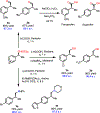CuH-Catalyzed Regio- and Enantioselective Formal Hydroformylation of Vinyl Arenes
- PMID: 38723265
- PMCID: PMC11439487
- DOI: 10.1021/jacs.4c04287
CuH-Catalyzed Regio- and Enantioselective Formal Hydroformylation of Vinyl Arenes
Abstract
A highly enantioselective formal hydroformylation of vinyl arenes enabled by copper hydride (CuH) catalysis is reported. Key to the success of the method was the use of the mild Lewis acid zinc triflate to promote the formation of oxocarbenium electrophiles through the activation of diethoxymethyl acetate. Using the newly developed protocol, a broad range of vinyl arene substrates underwent efficient hydroacetalization reactions to provide access to highly enantioenriched α-aryl acetal products in good yields with exclusively branched regioselectivity. The acetal products could be converted to the corresponding aldehydes, alcohols, and amines with full preservation of the enantiomeric purity. Density functional theory studies support that the key C-C bond-forming event between the alkyl copper intermediate and the oxocarbenium electrophile takes place with inversion of configuration of the Cu-C bond in a backside SE2-type mechanism.
Figures



Similar articles
-
Copper Hydride-Catalyzed Net Hydroformylation of Unactivated Terminal Olefins.Org Lett. 2025 Aug 8;27(31):8747-8751. doi: 10.1021/acs.orglett.5c02708. Epub 2025 Jul 26. Org Lett. 2025. PMID: 40776697
-
CuH-Catalyzed Olefin Functionalization: From Hydroamination to Carbonyl Addition.Acc Chem Res. 2020 Jun 16;53(6):1229-1243. doi: 10.1021/acs.accounts.0c00164. Epub 2020 May 13. Acc Chem Res. 2020. PMID: 32401530 Free PMC article.
-
Advances in Rhodium-Catalyzed Oxidative Arene Alkenylation.Acc Chem Res. 2020 Apr 21;53(4):920-936. doi: 10.1021/acs.accounts.0c00036. Epub 2020 Apr 2. Acc Chem Res. 2020. PMID: 32239913
-
Asymmetric functional organozinc additions to aldehydes catalyzed by 1,1'-bi-2-naphthols (BINOLs).Acc Chem Res. 2014 May 20;47(5):1523-35. doi: 10.1021/ar500020k. Epub 2014 Apr 16. Acc Chem Res. 2014. PMID: 24738985 Free PMC article. Review.
-
Teaching Aldehydes New Tricks Using Rhodium- and Cobalt-Hydride Catalysis.Acc Chem Res. 2021 Mar 2;54(5):1236-1250. doi: 10.1021/acs.accounts.0c00771. Epub 2021 Feb 3. Acc Chem Res. 2021. PMID: 33533586 Free PMC article. Review.
Cited by
-
Discovery of Staircase Chirality through the Design of Unnatural Amino Acid Derivatives.Research (Wash D C). 2024 Dec 19;7:0550. doi: 10.34133/research.0550. eCollection 2024. Research (Wash D C). 2024. PMID: 39703778 Free PMC article.
-
Enantiopure Turbo Chirality Targets in Tri-Propeller Blades: Design, Asymmetric Synthesis, and Computational Analysis.Molecules. 2025 Jan 29;30(3):603. doi: 10.3390/molecules30030603. Molecules. 2025. PMID: 39942707 Free PMC article.
References
-
- Stille JK In Comprehensive Organic Synthesis; Trost BM, Flemming I, Paquette LA, Eds.; Pergamon Press: Oxford, 1991; Vol. 4, p 913.
-
- (a) Bai S-T; Wen J; Zhang X Asymmetric Carbonylation Reactions. In The Chemical Transformations of C1 Compounds, Wu X-F; Han B; Ding K; Liu Z, Eds.; Wiley-VCH: 2022; pp 611–666;.
- (b) Franke R; Selent D; Börner A Applied Hydroformylation. Chem. Rev 2012, 112, 5675–5732. - PubMed
-
- Bohnen HW; Cornils B Hydroformylation of alkenes: An industrial view of the status and importance. Adv. Catal 2002, 47, 1–64.
-
- (a) Claver C; van Leeuwen PWNM; Claver C; van Leeuwen PWNM Rhodium Catalyzed Hydroformylation; Springer: Berlin, 2002.
- (b) Hebrard F; Kalck P Cobalt-Catalyzed Hydroformylation of Alkenes: Generation and Recycling of the Carbonyl Species, and Catalytic Cycle. Chem. Rev 2009, 109, 4272–4282. - PubMed
Grants and funding
LinkOut - more resources
Full Text Sources

